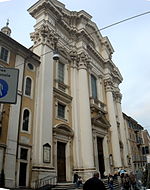San Lorenzo in Lucina
1650 establishments in Italy1650 establishments in the Papal States17th-century Roman Catholic church buildings in Italy4th-century churchesBasilica churches in Rome ... and 2 more
Churches of Rome (rione Colonna)Roman Catholic churches completed in 1650

The Minor Basilica of St. Lawrence in Lucina (Italian: Basilica Minore di San Lorenzo in Lucina or simply Italian: San Lorenzo in Lucina; Latin: S. Laurentii in Lucina) is a Roman Catholic parish, titular church, and minor basilica in central Rome, Italy. The basilica is located in Piazza di San Lorenzo in Lucina in the Rione Colonna, about two blocks behind the Palazzo Montecitorio, proximate to the Via del Corso.
Excerpt from the Wikipedia article San Lorenzo in Lucina (License: CC BY-SA 3.0, Authors, Images).San Lorenzo in Lucina
Piazza di San Lorenzo in Lucina, Rome Municipio Roma I
Geographical coordinates (GPS) Address External links Nearby Places Show on map
Geographical coordinates (GPS)
| Latitude | Longitude |
|---|---|
| N 41.903416666667 ° | E 12.478694444444 ° |
Address
Basilica di San Lorenzo in Lucina
Piazza di San Lorenzo in Lucina
00186 Rome, Municipio Roma I
Lazio, Italy
Open on Google Maps









